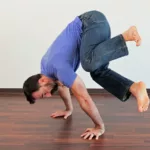Most training programs look like a grocery list:
– squats 3×10
– push-ups 3×10
– etc.
But life doesn’t work that way.
In the real world, you squat down to grab something, immediately turn and carry it somewhere, then set it down and stand back up – all as one continuous sequence.
Most workouts completely ignore this reality, but it’s easy to fix.
How Movement Flow Fills the Exercise-Performance Gap
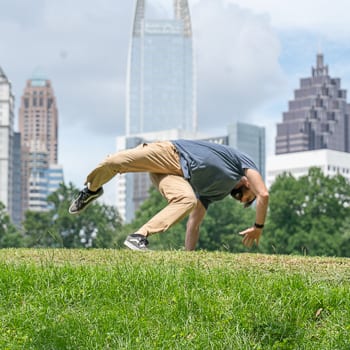 The gap between isolated exercises and continuous movement in real life is why strong gym-goers still get hurt doing basic daily activities.
The gap between isolated exercises and continuous movement in real life is why strong gym-goers still get hurt doing basic daily activities.
You can nail the individual movements but fail at the transitions between them.
That’s also where most injuries happen – not at the bottom of your squat, but in the split second when you’re changing direction or shifting from one movement to the next. Sports injuries, ditto – they happen during a change of momentum.
Movement flow training fills this gap.
It builds the reflexive control to handle momentum changes safely, develops the reactive ability to adapt when things don’t go as planned, and creates the efficient, graceful movement transitions that make everyday activities feel effortless instead of risky.
Here’s some examples:
Now look: I’m not comparing myself to actual elite athletes, but that’s kind of the point.
When you’re able to string together some fundamental movements smoothly on the fly, the result is something way more impressive than the sum of its parts.
“Flow” has been a buzzword in the fitness and movement culture world for quite a while now, but it doesn’t mean much unless you’ve actually trained the skills and learned how to link them. That’s where the real stuff is, and why we’ve been emphasizing that from the start.
Not for looking cool but for moving well.
Why You Should Train To Move Well, Not Just Move a Lot
Most of us reading this aren’t training as a professional athlete.
Yet that’s where a lot of the “more is better” mentality comes from. From college sports to pros, they have to pile on a lot of hours and training to be competitive.
And frankly, a lot of them don’t survive it. The ones that do often have a lot of chronic issues.
It might be necessary for them, but it’s definitely not for the rest of us. We can achieve our goals of health and fitness without those tradeoffs.
Developing Your Movement Flow Makes You a More Capable Human
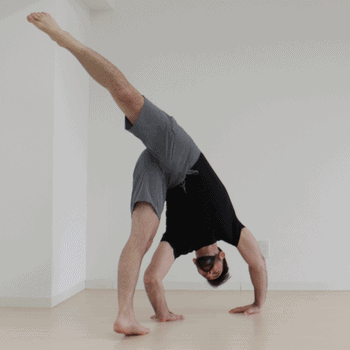 When you develop the ability to easily connect every movement you make it’s kind of like painting a picture in one brushstroke, without letting your paint brush lift off the canvas.
When you develop the ability to easily connect every movement you make it’s kind of like painting a picture in one brushstroke, without letting your paint brush lift off the canvas.
Moving with control, slowing down or speeding up as needed, and adjusting on the fly becomes automatic. Without this ability, you could wind up with something that looks quite different from what you envisioned. With this ability, your painting matches your vision.
How you picture yourself moving and accomplishing your goal, in sport, activity, and life becomes how you actually move. It’s a real empowerment.
And the process of building this fluid, capable movement makes your body so much stronger and more adaptable. So that, even if you never fully achieve that “pro-level” flowy movement, the very act of aiming for that kind of movement makes you better.
Fluid Mobility That Shows Up When You Need It

Most mobility work happens in isolation with passive stretching, rigid prescriptions, and warmups that are disconnected from the actual meat of your workout. Flow training leads you in a different direction.
Because flow work has you constantly moving into and out of different positions with control and intent, it’s fundamentally building your mobility in the way that you need it.
The ranges of motion you gain you’ll see in more than just a particular stretch or exercise. It’s there when you twist to grab something behind you and when you have to lunge and kneel so quickly you don’t think about it.
Like when you’re running errands in the rain and have to hop up on a curb to get around a deep puddle, then shift your body around to make sure you don’t slip.
Training Movement Flow Trains Your Brain
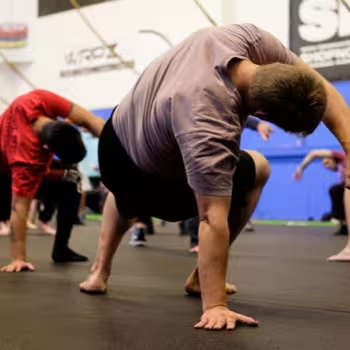 Unlike isolated movements, training for movement flow build more than just muscles. The practice of connecting things together smoothly challenges your nervous system to plan, adjust, and adapt.
Unlike isolated movements, training for movement flow build more than just muscles. The practice of connecting things together smoothly challenges your nervous system to plan, adjust, and adapt.
It’s normal to feel bored when you spin endlessly on a bike or trudging along on a treadmill. That’s why we listen to music or podcasts, you’re moving your body in the same pattern over and over again. Your brain doesn’t need to be involved!
This doesn’t happen in flow training, you’re automatically engaged and mindful because you have to be. Otherwise you’ll keep tripping up. As you get more practice under your belt you won’t have to concentrate so much. But at that point you won’t just be daydreaming, you’ll be shifting your focus towards other meaningful details to make your movement even smoother.
In training for flow, you’re rewiring how your body/mind learns and understands movement.
Flow training gives you:
- Better body awareness that carries over into everything you do
- More reliable movement under unpredictable conditions
- Skills that stick longer because they’re built through exploration and feedback not just mindless repetition
How to Integrate movement Flow into Your Training
Movement flow doesn’t come from doing more of the same.
It comes from learning how to move with control, connection, and intent. This can be tough since it’s so different from what we’re told exercise is “supposed” to look like.
But there are concrete steps you can take to learn how to move this way.
1. Practice The Fundamentals (Yes, Even The Easy Stuff)
 Smooth movement starts with the basics.
Smooth movement starts with the basics.
Practicing and getting good at basic movement patterns is the first step to gaining a high level of control over your body. Building and maintaining this foundation is essential to keep making progress in your movement ability and capability.
We developed our Elements program to provide the essential basics for a broad range of physical activities. These movement patterns develop your overall strength, flexibility, and control.
2. Layer In Complexity To Further Build Control
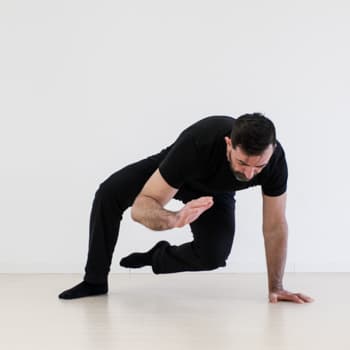 As you gain mastery over those basic movement patterns, you can gradually begin to add in complexity.
As you gain mastery over those basic movement patterns, you can gradually begin to add in complexity.
Complexity is more than making movements more difficult. Instead, think of adding layers of variability that aren’t possible in singular planes of motion.
There are many different ways to add complexity to your movements. We talk about that a lot more in this article, but it can be as simple as changing angles of direction or adding a balance challenge.
Complexity, applied progressively, helps your nervous system adapt and consolidate all of this variability into all of your movement.
3. Link Movements Together in Combinations
 The next piece of making your movements flow seamlessly is linking different movements together. Learn to go from one exercise or movement into the next, then the next, and so on.
The next piece of making your movements flow seamlessly is linking different movements together. Learn to go from one exercise or movement into the next, then the next, and so on.
For instance, you may go from a squat into a monkey (a lateral moving squat) into a cartwheel, then back into a squat, ending off with a forward roll.
At first it won’t feel smooth, if they did then you’d already have it all figured out! Just like in all learning, it takes practice and time to tighten up those gaps and smooth out the stutters.
But you’ll get it.
4. Focus on Movement Quality over Intensity
 One of the big mistakes we see is people trying to muscle through movements. Or falling back into making everything intense.
One of the big mistakes we see is people trying to muscle through movements. Or falling back into making everything intense.
There’s a time and a place for intensity in your exercise, but for flow and control, it will run counter to your efforts.
It’s like revving up your car and spinning your wheels, you’re not going to get anywhere. smoothly and seamlessly, intensity won’t get you there. Quality movement will.
The goal should always be to “make it pretty” by paying attention to the details and trying to make your form smoother and smoother each time you practice. Eventually, you’ll achieve that “wow” factor you love watching.
Build Seamless, Athletic Movement With Elements & Sequences
We’ve been building movement flow into our training programs since 2010, with over 125k clients developing more fluidity in their movements.
Elements includes all the essential movement patterns at the heart of functional movement. It also teaches you basic combinations so you can feel capable and confident in all the transitions and “in-between” moves that make up your life.
Floor Loco uses those same movements, plus a couple extras, to build 5 fun and useful movement flow routines that build even more fluidity.
Sequences builds on that foundation with more dynamic power moves and flows of greater complexity and challenge.





